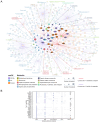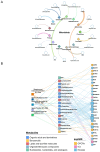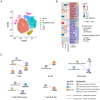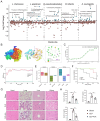Comprehensive characterization of multi-omics landscapes between gut microbial metabolites and the druggable genome in sepsis
- PMID: 40761792
- PMCID: PMC12318984
- DOI: 10.3389/fimmu.2025.1597676
Comprehensive characterization of multi-omics landscapes between gut microbial metabolites and the druggable genome in sepsis
Abstract
Background: Sepsis is a life-threatening condition with limited therapeutic options. Emerging evidence implicates gut microbial metabolites in modulating host immunity, but the specific interactions between these metabolites and host druggable targets remain poorly understood.
Methods: We utilized a systems biology framework integrating genetic analyses, multi-omics profiling, and structure-based virtual screening to systematically map the interaction landscape between human gut microbial metabolites and druggable G-protein-coupled receptors (GPCRs), ion channels (ICs), and kinases (termed the "GIKome") in sepsis. Key findings were validated by molecular dynamics (MD) simulation, microscale thermophoresis (MST), and functional assays in a murine cecal ligation and puncture (CLP) model of sepsis.
Results: We evaluated 190,950 metabolite-protein interactions, linking 114 sepsis-related GIK targets to 335 gut microbial metabolites, and prioritized indole-3-lactic acid (ILA), a metabolite enriched in Akkermansia muciniphila, as a promising therapeutic candidate. MD simulation and MST further revealed that ILA binds stably to PFKFB2, a pivotal kinase in regulating glycolytic flux and immune activation during sepsis. In vivo, ILA administration improved survival, attenuated cytokine storm, and mitigated multi-organ injury in CLP-induced septic mice.
Conclusions: This systems-level investigation unveils previously unrecognized therapeutic targets, offering a blueprint for microbiota-based precision interventions in critical care medicine.
Keywords: GPCRs; Mendelian randomization; ion channels; kinases; microbial metabolites; sepsis.
Copyright © 2025 Liu, Li, Xin, Li, Zhang and Zhu.
Conflict of interest statement
The authors declare that the research was conducted in the absence of any commercial or financial relationships that could be construed as a potential conflict of interest.
Figures







Similar articles
-
Systematic characterization of multi-omics landscape between gut microbial metabolites and GPCRome in Alzheimer's disease.Cell Rep. 2024 May 28;43(5):114128. doi: 10.1016/j.celrep.2024.114128. Epub 2024 Apr 21. Cell Rep. 2024. PMID: 38652661 Free PMC article.
-
Comprehensive multi-omics analysis reveals the core role of glycerophospholipid metabolism in the influence of short-chain fatty acids on the development of sepsis.Sci Rep. 2025 Aug 9;15(1):29164. doi: 10.1038/s41598-025-13322-7. Sci Rep. 2025. PMID: 40783504 Free PMC article.
-
Integrated multi-omics analysis reveals the functional signature of microbes and metabolomics in pre-diabetes individuals.Microbiol Spectr. 2025 Jul;13(7):e0145924. doi: 10.1128/spectrum.01459-24. Epub 2025 Jun 9. Microbiol Spectr. 2025. PMID: 40488467 Free PMC article.
-
The Discovery of Gut Microbial Metabolites as Modulators of Host Susceptibility to Acetaminophen-Induced Hepatotoxicity.Drug Metab Dispos. 2024 Jul 16;52(8):754-764. doi: 10.1124/dmd.123.001541. Drug Metab Dispos. 2024. PMID: 38302428 Free PMC article. Review.
-
A Systems Biology Approach to Memory Health: Integrating Network Pharmacology, Gut Microbiota, and Multi-Omics for Health Functional Foods.Int J Mol Sci. 2025 Jul 12;26(14):6698. doi: 10.3390/ijms26146698. Int J Mol Sci. 2025. PMID: 40724948 Free PMC article. Review.
References
MeSH terms
Substances
LinkOut - more resources
Full Text Sources
Medical
Research Materials
Miscellaneous

